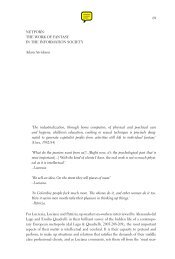Nakamura, Digitizing Race, Introduction, chapter 5, Epilogue
Nakamura, Digitizing Race, Introduction, chapter 5, Epilogue
Nakamura, Digitizing Race, Introduction, chapter 5, Epilogue
Create successful ePaper yourself
Turn your PDF publications into a flip-book with our unique Google optimized e-Paper software.
16 <strong>Introduction</strong><br />
differential access to digital visual capital, as well as the distinctive means<br />
by which people of color and women create and in some sense redefine it.<br />
Women and people of color are both subjects and objects of interactivity;<br />
they participate in digital racial formation via acts of technological appropriation,<br />
yet are subjected to it as well.<br />
In John Berger’s influential visual culture primer Ways of Seeing, the subject<br />
is defined as that which views, and the object as that which submits or<br />
is subjected to the gaze: he dubs these two positions that of the “surveyor”<br />
and the “surveyed.” 25 He is most famously concerned with the gendering<br />
operations of the gaze in portraiture and pornography, but his success in<br />
creating a critical framework and methodology has much to do with his<br />
parsing of power relations in the field of the visual. Digital visual culture<br />
presents a challenge to this formulation: while the difference between the<br />
viewer and the viewed, the producer/artist and the subject/model, was clear<br />
in more traditional art (while reading Berger, it is always clear who he means<br />
by “artist,” “spectator/owner,” and “object” of representation), it is not so<br />
clear when discussing networked digital media. New media are produced<br />
and consumed differently. In addition, we often get the double layer of performance<br />
that comes with the viewer’s act of clicking.<br />
So rather than focusing on the idea that women and minorities need to<br />
get online, we might ask: How do they use their digital visual capital? In<br />
what ways are their gendered and racialized bodies a form of this new type<br />
of capital? What sort of laws does this currency operate under? It doesn’t<br />
change everything, but what does it change? This brings us back to the<br />
privileging of interactivity and its traditional linkage with the creation of a<br />
newly empowered subject.<br />
According to Lev Manovich’s provocative “myth of interactivity,” “interactive<br />
media ask us to identify with someone else’s mental structure.” Rather<br />
than allowing the user to have an open-ended, seemingly limitless and boundless<br />
experience of reading, Manovich stresses the rigidity of hyperlinking as<br />
a mode of experiencing information: when “interactive media asks us to<br />
click on a highlighted sentence to go to another sentence . . . we are asked<br />
to follow pre-programmed, objectively existing associations.” 26 According<br />
to this interpretation, we are ideologically interpellated into the “new media<br />
designer’s mental trajectory,” just as in Hollywood film we are asked to “lust<br />
after and try to emulate the body of the movie star.” Manovich’s formulation<br />
allows us to trace the process of identification that occurs with new media<br />
use: he compares it to the viewer’s process of identification with the star’s<br />
body in the realm of film. And just as we have a well-developed theory of





